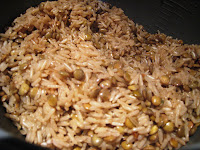Ingredients
brown rice
black-eyed peas (1 c dried makes about 2-3 c cooked)
water to cover the peas
1 T powdered veggie broth (I get mine in bulk at Whole Foods)
1 t smoked paprika
2 t cumin
4 links veggie sausage, diced
1 onion, diced
2 carrots, diced
3 cloves garlic, minced
1 pkg frozen spinach
2 T Bragg's liquid aminos
2 T nutritional yeast
black pepper to taste
Method
After soaking peas for about 8 hours, drain and rinse well, then return to your pot. Add enough water to cover by at least 2 inches, then add your (salt-free!) veg broth powder, cumin, and paprika. Bring to boil, lower heat, and simmer for about an hour.
Meanwhile, cook your brown rice.
About half an hour before the peas are done, start preparing the rest of the ingredients. First, in a large sauté pan, brown your veggie sausage in a little cooking oil. Remove from pan, give it a wipe (or not), add a little cooking oil, and sauté your onion and carrots until softened. Add your spinach and a ladle or two of the cooking water from your peas and stir. Cover and simmer until the spinach is cooked. Add your sausage and mix well, then set aside until the peas are done. Once they're finished, combine your veggies and sausage with your peas. At this point, you may want to remove some of the water -- it depends on how much liquid you started with and how soupy you want the final product to be. I went for a stew-like consistency rather than a soup, but it's up to you.
Season the whole thing with Bragg's, nooch, and black pepper to taste and serve over brown rice (or mix the rice in with everything else if you like).
 I love my bread machine. It's an
I love my bread machine. It's an 







